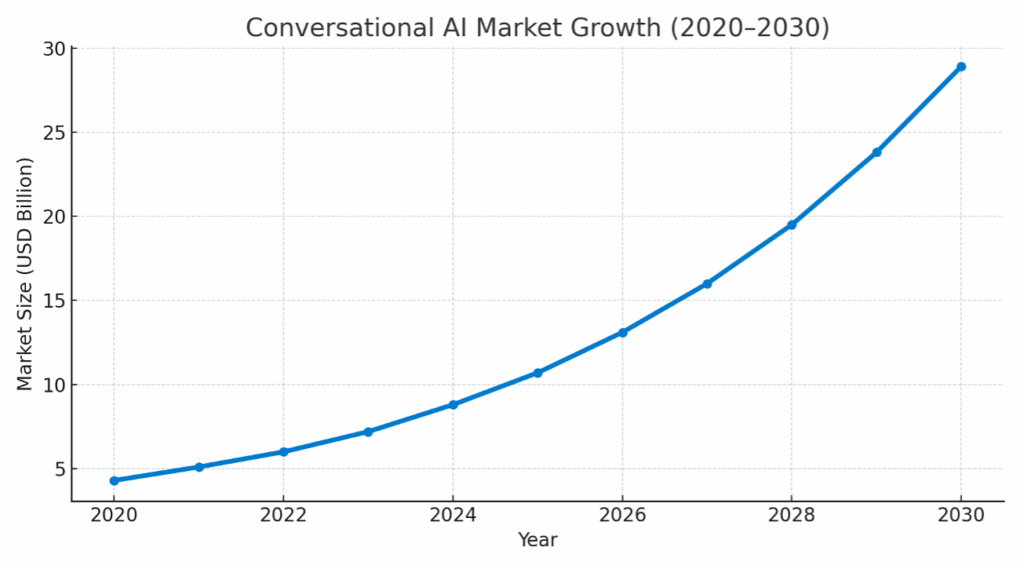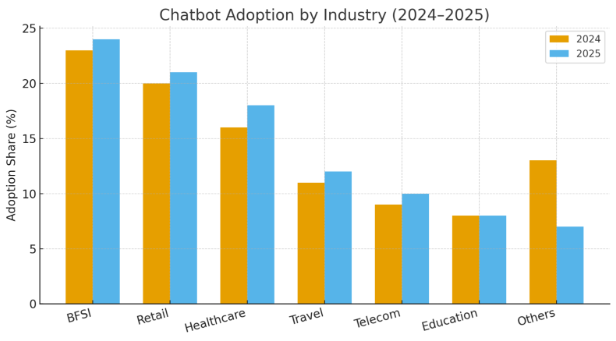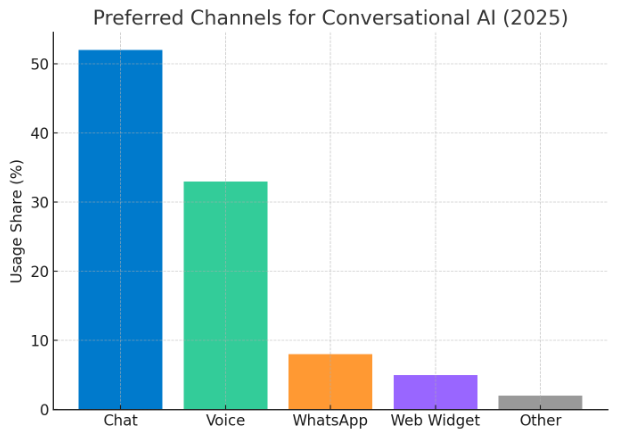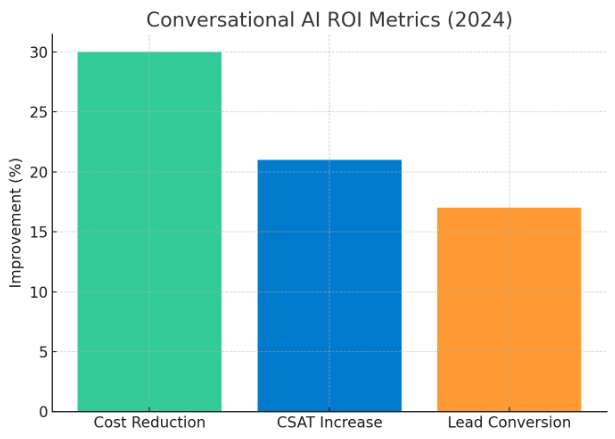Chatbots & Conversational AI
Creating Human-Like Digital Interactions Powered by Intelligence
At Sense & Respond Software, we build AI-driven conversational systems that help organizations communicate, support, and engage with customers at scale — naturally, contextually, and intelligently.
The Global Conversational AI Ecosystem (2024–2025)
Mobile platforms have become intelligent ecosystems — merging software, hardware, and cloud. These visuals anchor our technology choices.
Market Size:
$17.8B in 2024 → projected to reach $47.6B by 2030 (22% CAGR, Markets and Markets).
Enterprise Adoption:
63% of global enterprises deploy conversational AI for support, onboarding, or sales (Gartner 2025).
Generative AI Acceleration:
72% of new chatbot deployments integrate LLMs (OpenAI GPT, Claude, Gemini).
Voice Growth:
Voice-first usage now accounts for 55% of conversational interactions globally.
ROI Impact:
Companies see 25–40% cost reduction in customer support and 20%+ improvement in satisfaction.
Key Data Visuals
Conversational AI Market Growth (2020–2030)

Chatbot Adoption by Industry (2024–2025)

Conversational Channel Preference (2025)

Conversational AI ROI Metrics (2024)

Our Experience-First Approach
Designing Conversations That Feel Human
Conversational AI succeeds when it’s designed for human connection — empathetic, contextual, and aware.
We combine UX design, linguistics, and machine learning to create chatbots that understand not just what users say, but what they mean
1. Understanding Intent and Context
We begin by mapping customer intents, emotions, and friction points across key journeys. Through deep discovery, we align chatbot goals to business outcomes and customer expectations.
Our discovery deliverables include:
- Intent taxonomies and conversation flow maps
- Contextual memory models for multi-turn conversations
- Brand-aligned tone and persona design
- Language model fine-tuning for domain-specific accuracy
2. Engineering Scalable Conversational Systems
Behind every great conversation is a great architecture — modular, cloud-native, secure, and data-driven.
Our Engineering Framework
Layer
NLU/NLP
Tools & Platforms
Rasa, Dialogflow CX, Azure Cognitive, IBM Watson
Purpose
Intent recognition, entity extraction
Layer
Generative AI
Tools & Platforms
OpenAI GPT models, Gemini, Claude
Purpose
Contextual and creative responses
Layer
Voice AI
Tools & Platforms
Amazon Lex, Whisper API, Speech SDKs
Purpose
Speech-to-text, TTS, multilingual voice bots
Layer
Middleware
Tools & Platforms
Node.js, FastAPI, Kafka
Purpose
Orchestration, event routing, async ops
Layer
Integration
Tools & Platforms
REST, GraphQL, WebSocket, API Gateway
Purpose
CRM, ERP, and knowledge base connection
Layer
Data & Logging
Tools & Platforms
PostgreSQL, MongoDB, Elastic
Purpose
Store conversations and analytics
Layer
Deployment
Tools & Platforms
AWS Lambda, Azure Functions, Cloud Run
Purpose
Serverless and scalable cloud operations
Layer
Tools & Platforms
Purpose
NLU/NLP
Rasa, Dialogflow CX, Azure Cognitive, IBM Watson
Intent recognition, entity extraction
Generative AI
OpenAI GPT models, Gemini, Claude
Contextual and creative responses
Voice AI
Amazon Lex, Whisper API, Speech SDKs
Speech-to-text, TTS, multilingual voice bots
Middleware
Node.js, FastAPI, Kafka
Orchestration, event routing, async ops
Integration
REST, GraphQL, WebSocket, API Gateway
CRM, ERP, and knowledge base connection
Data & Logging
PostgreSQL, MongoDB, Elastic
Store conversations and analytics
Deployment
AWS Lambda, Azure Functions, Cloud Run
Serverless and scalable cloud operations
3. Continuous Optimization (Sense & Respond Loop)
Every message exchanged with a user is a learning event. We treat conversation data as live feedback that fuels continuous improvement.
Our optimization process:
- Sense: Capture live chat logs, user feedback, sentiment, and drop-off points.
- Analyze: Use AI analytics to detect intent gaps, frequent fallbacks, and tone misalignments.
- Respond: Refine conversation design, update ML models, and optimize flows.
- Automate: Deploy retraining jobs and rollout improvements seamlessly.
Optimization Tools and Practices:
- Dashbot, Elastic Observability, Dialogflow Analytics
- LLM fine-tuning pipelines with continuous evaluation metrics
- Automated regression tests for conversational logic
- A/B testing of greeting messages, tones, and CTA responses
- Weekly conversational analytics review and action tracking
4. Multi-Channel & Omnichannel Experience
We deploy chatbots wherever your customers are:
- Web & Mobile Apps – embedded widgets and SDKs
- Social Platforms – WhatsApp, Facebook, Instagram, Telegram
- Enterprise Tools – Microsoft Teams, Slack, Salesforce integration
- Voice Assistants – Alexa, Google Assistant, custom enterprise bots
Each channel maintains tone, logic, and memory synchronization for a consistent user experience.
Best Practices: What Works Consistently
How We Build Conversational Systems That Truly Work
Empathy by Design:
Craft responses that mirror human tone and use active listening cues (“I understand,” “Let’s fix this together”).
Multi-turn Intelligence:
Maintain conversation memory across sessions to prevent repetition.
Balanced Automation:
Blend AI automation with easy human handoffs for complex queries.
Personalization at Scale:
Integrate CRM data to personalize interactions dynamically.
Security First:
Encrypt data in motion and at rest, mask PII, and implement token-based session tracking.
Governance & Auditability:
Maintain chat logs with consent tracking, redaction rules, and explainability reports for AI responses.
Localization with Cultural Sensitivity:
Translate tone, metaphors, and politeness norms — not just words.
Feedback-Driven Evolution:
Embed “thumbs up/down” feedback loops directly into the conversation.
Conversation Analytics:
Dashboards tracking intent recognition accuracy, sentiment polarity, and user satisfaction.
Ethical & Safe AI:
Guard against misinformation and bias; implement moderation layers for generated content.
LLM-Orchestration Best Practice:
Always pair LLM outputs with retrieval-augmented data (RAG) to maintain factual accuracy.
Omnichannel Consistency:
Keep personality and tone coherent across web, mobile, voice, and messaging platforms.
Performance Optimization:
Pre-warm intents, use caching for frequent queries, and optimize latency under 2 seconds.
Compliance-Ready Design:
Build systems aligned with GDPR, CCPA, HIPAA, and India’s DPDP Act.
Conversational excellence blends empathy, data, and engineering discipline.
Lessons Learned: What Not to Do
Insights from Scaling Conversational Systems Globally
Over-Automation Without Personality
Robots pretending to be human break trust. Design for warmth and transparency.
Ignoring Live Analytics:
Without metrics, you’re flying blind. Review dashboards weekly.
No Model Maintenance:
AI models decay over time. Retrain monthly to sustain accuracy.
Unsecured Logs:
Chat logs often contain PII. Mask and encrypt by design.
Limited Domain Understanding:
Generic bots frustrate users. Train on domain-specific data.
No Fallbacks or Escalation:
Dead ends kill trust. Always design graceful fallback paths.
Literal Translation for Multilingual Support:
Language ≠ culture. Use localization experts and tone adaptation.
Ignoring Testing:
Testing conversation flows manually only once before launch is risky. Automate conversation regression tests.
No Human-in-the-Loop:
Pure automation fails at empathy. Blend automation with live agent takeover options.
No Ethics or AI Controls:
personalization, predictive search, conversational experiences
Chatbots fail not because of technology — but because they forget the human behind the interaction.
Global Perspective
India
- India’s AI ecosystem is one of the fastest-growing globally, with Bengaluru and Hyderabad as leading conversational AI hubs.
- Local enterprises deploy multilingual bots serving 20+ Indian languages.
- Government and BFSI sectors leverage bots for citizen engagement and service automation.
United States
- The U.S. drives 40% of the global conversational AI market, led by California and New York.
- Generative AI adoption in chatbots grew +60% YoY in 2024–2025.
- Enterprises integrate LLMs for real-time personalization and intelligent virtual agents.
